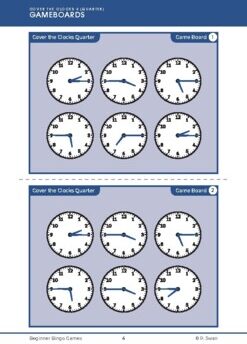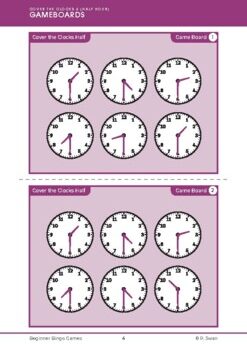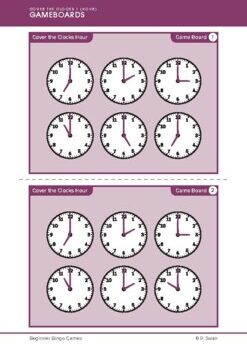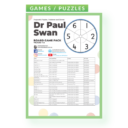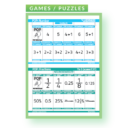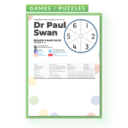Milestones:
Telling the Time
For your classroom
Getting started
Check the ACARA website for the most up-to-date Curriculum, as well as your state curriculum if needed.
Version “Aug 2021”
Telling the Time Milestones Sheet
The Milestones provide a default position for schools to adopt a whole school approach for the development of properties and mental strategies associated with telling the time.
Having a whole school approach is essential and the Milestones suite of resources provides a platform for schools to work from.
Even if you don’t adopt the Milestones steps, you can make use of the linked materials.

Telling the Time Milestones
Relevant Materials
-
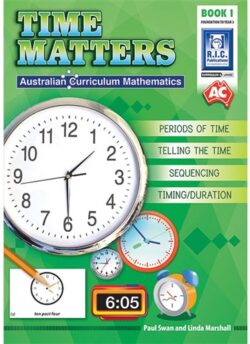 Quick ViewAdd to cart
Quick ViewAdd to cart -
 Quick ViewSelect options
Quick ViewSelect options -
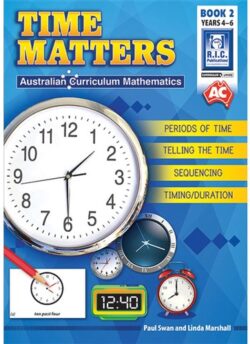 Quick ViewAdd to cart
Quick ViewAdd to cart
Year 1
Year 1 Prerequisites
Yr 1 ACMMG020: Tell time to the half-hour. reading time on analogue and digital clocks
Starting Point
Give students a blank page and ask them to draw a circular clock (analogue) showing four o’clock.
- Are the digits distributed evenly around the circle?
- Note not all clock faces are circular.
Number line 1 – 12
Recognise that the number line can be curved. Consider many scales are curved. Note when circular the 12 is at the starting position replacing zero and represents the o’clock position.
Relevant Sections
TM1 –Time Matters Book 1 (Swan & Marshall)
M&G1 – Measurement and Geometry Year 1 (Marshall)
M&G2 – Measurement and Geometry Year 2 (Marshall)
M&G3 – Measurement and Geometry Year 3 (Marshall)
Relevant Sections
Time Curriculum Thread (Contains First Steps Materials)
Time Match Games
Time POP
Identifying the Hands
- Minute hand: longer hand – points to 12 in o’clock times
- Hour Hand: shorter hand – the number the hour hand points to represents the o’clock time.
Relevant Sections
- Overlapping hour clock – TM1 p. 33
- Questions for teachers to ask – TM1 p. 34
- Show my time – TM1 p. 36
Relevant Free Stuff
–
Tell the time to the hour (analogue)
- Show each hour starting from 1:00, leave 6:00 and 12:00 to last.
- Physically move hands on a clock to show the time given orally.
- Eventually link digital clock to analogue clock.
- Recognise that digitally, o’clock times are shown as _ _:00
Relevant Sections
- Making personal analog clocks – TM1 p. 34
- Making personal digital clocks – TM1 p. 35
- Imagine a clock – TM1 p. 35
- Different orientations – TM1 p. 35
- Becoming a clock – TM1 p. 35
- Draw the times – TM1 p. 40
- What’s the time Mr Wolf – TM1 p. 43
- Clock Noughts and crosses – TM1 p. 44
- Clock Bingo – TM1 p.52
- Time Concentration – TM1 p. 57
- Time Dominoes – TM1 p. 67
- Self-checking Time cards – TM1 p. 75
- Class clock – M&G1 p.13
- Match the times 1 – M&G1 p.25
Relevant Free Stuff
Half Past Times (visual/graphic)
- Minute hand points to 6 in ‘half past’ times.
- Fraction understanding: the minute hand has travelled half way around the clock.
Fold circular paper to demonstrate. - Understand that as the minute hand moves around the clock the hour hand moves only a small distance. At half past the hour the hour hand will be half way between two numbers.
Relevant Sections
- Overlapping hour clock – TM1 p. 33
- Making personal analog clocks – TM1 p. 34
- Fraction ideas in any of Paul’s books???
Relevant Free Stuff
–
Half Past Times (digital)
- Recognise that Half past times are shown as _ _:30 on a digital clock.
- Times may be spoken as ‘half past’ or ‘_ thirty’.
Relevant Sections
- Clock Bingo – TM1 p.52
- Draw the times – TM1 p. 41
Relevant Free Stuff
Tell the time to the half hour (analogue)
- Physically move hands on a clock to show the time given orally. Both the minute and hour hands will need to be moved.
- Eventually link digital clock to analogue clock.
- Read time on analogue and digital clocks.
Relevant Sections
- Overlapping hour clock – TM1 p. 33
- Making personal analog clocks – TM1 p. 34
- Draw the times – TM1 p. 40
- Clock Bingo – TM1 p.52
- Self-checking Time cards – TM1 p. 76
- Match the times 2 – M&G1 p.26
Relevant Free Stuff
Times Over a Day
- Students need to realise the same time occurs twice each day; e.g. 7 o’clock in the morning and 7 o’clock at night.
- Distinguish between am (morning) and pm (afternoon)
Relevant Sections
TBA
Relevant Free Stuff
Year 2
Year 2 Prerequisites
Yr 2 ACMMG039: Tell time to the quarter-hour, using the language of ‘past’ and ‘to’
Start of the year review:
O’Clock times using standard analogue clock face.
Review all half past times using standard clock face
Introduce clock variations:
roman numerals, missing digits, non-circular face.
variations first only on o’clock times, expanding to half-past times
Relevant Sections
TBA
Relevant Free Stuff
Quarter Past
- Minute hand points to 3 in ‘quarter past’ times.
- Fraction understanding: the minute hand has travelled a quarter of the way around the clock.
- Fold circular paper into quarters & shade.
Relevant Sections
- Overlapping hour clock – TM1 p. 33
- Fraction ideas
Relevant Free Stuff
Quarter Past - Minute Hand Movement
- Understand that as the minute hand moves around the clock the hour hand moves only a small distance. At quarter past the hour the hour hand will be one quarter of the way between two numbers.
Relevant Sections
- Overlapping hour clock – TM1 p. 33
- Making personal analog clocks – TM1 p. 34
- Imagine a clock – TM1 p. 35
- Different orientations – TM1 p. 35
- Becoming a clock – TM1 p. 35
- Clock Bingo – TM1 p.52
- Time Concentration – TM1 p. 57
- Time Dominoes – TM1 p. 67
- One-handed clock – TM1 p. 38
- Self-checking Time cards – TM1 p. 77
- Match the times – M&G2 p. 38
- Draw the times – M&G2 p. 39
Relevant Free Stuff
–
Quarter Past (Digital)
- Recognise that quarter past times are shown as _ _:15 on a digital clock.
- Times may be spoken as ‘quarter past’ or ‘_ fifteen’.
Relevant Sections
- Making personal digital clocks – TM1 p. 35
- Clock Bingo – TM1 p.52
- Time Concentration – TM1 p. 57
- Time Dominoes – TM1 p. 67
- Match the times – M&G2 p. 38
- Draw the times – M&G2 p. 39
Relevant Free Stuff
Quarter To
- Minute hand points to 9 in ‘quarter to ’ times.
- Fraction understanding: Minute hand has travelled three-quarters of the way around the clock but only one quarter to go.
Relevant Sections
- Overlapping hour clock – TM1 p. 33
Relevant Free Stuff
Quarter To - Minute Hand Movement
- Understand that as the minute hand moves around the clock the hour hand moves only a small distance. At quarter to the hour the hour hand will be three-quarters of the way between two numbers.
- Place minute and hour hands correctly on a clock given digital representation, written representation and spoken time.
- Read time from a variety of clocks.
Relevant Sections
- Overlapping hour clock – TM1 p. 33
- Imagine a clock – TM1 p. 35
- Different orientations – TM1 p. 35
- Becoming a clock – TM1 p. 35
- Clock Bingo – TM1 p.52
- Time Concentration – TM1 p. 57
- Time Dominoes – TM1 p. 67
- One-handed clock – TM1 p. 38
- Self-checking Time cards – TM1 p. 77
- Match the times – M&G2 p. 38
- Draw the times – M&G2 p. 39
Relevant Free Stuff
Quarter To (Digital)
- Recognise that quarter past times are shown as _ _:45 on a digital clock. Times may be spoken as ‘quarter to’ or ‘_ forty-five’.
- Language issue: Nine forty five vs quarter to ten
Relevant Sections
- Making personal digital clocks – TM1 p. 35
- Clock Bingo – TM1 p.52
- Time Concentration – TM1 p. 57
- Time Dominoes – TM1 p. 67
- Self-checking Time cards – TM1 p. 77
- Match the times – M&G2 p. 38
- Draw the times – M&G2 p. 39
Relevant Free Stuff
Year 3
Year 3 Prerequisites
Yr3 ACMMG062: Tell time to the minute …
recognising there are 60 minutes in an hour and 60 seconds in a minute
Start of the year review:
- O’Clock
- half past
- quarter past
- quarter to times
- using standard analogue clock faces
- Review some variations. Include digital representation.
Relevant Sections
TBA
Relevant Free Stuff
Time to the 5 Minutes
- Ability to count in fives to sixty
- Recognise each digit represents a multiple of five.
- Recognising that when the minute hand moves from one digit to the next, five minutes has passed.
- Link _ _:15, quarter past to _ _ fifteen
- Link _ _:45, quarter to, to _ _ forty-five
Progress to intervals of ten:
_ _:10 ten past
_ _ ten
_ _:20 twenty past
_ _ twenty
Note after ‘half past’ the language changes – the hour shown on ‘to’ times is one more on an analogue clock when compared with a digital clock
_ _: 40 twenty to,
and _ _ forty
_ _: 50, ten to
and _ _ fifty
Progress to intervals of five
_ _: 05, five past, _ _ oh five
_ _ : 25, twenty-five past, _ _ twenty-five
Note after ‘half past’ the language can change
e.g. _ _:35, twenty five to (the next number),
but the preferred language is _ _ thirty five.
_ _:55, five to (the next number), _ _ fifty five
Place minute and hour hands correctly on a clock given digital representation, written representation and spoken time.
Relevant Sections
- Making personal analog clocks – TM1 p. 34
- Making personal digital clocks – TM1 p. 35
- Five-minute time cards – TM1 p. 50
- Clock Bingo – TM1 p.52
- Time Concentration – TM1 p. 57
- Time Dominoes – TM1 p. 67
- Self-checking Time cards – TM1 p. 78
- Race around the clock face – TM1 p. 81
- Number line activity by fives – M&G3 p. 18
- Five-minute time cards – M&G3 p. 20
Relevant Free Stuff
Time to the Minute
- Time to the minute
- Ability to count in ones to sixty
- Recognise each interval on the number line (scale) represents a minute.
- Recognising that when the minute hand moves to the next interval, one minute has passed.
- Introduce second hand. In the time it takes to complete a rotation of the clock or watch face one minute will have passed and the minute hand will have moved one interval. That is 60 seconds = 1 minute.
Relevant Sections
- Making personal analog clocks – TM1 p. 34
- Making personal digital clocks – TM1 p. 35
- One-minute time cards – TM1 p. 51
- Clock Bingo – TM1 p.52
- Time Dominoes – TM1 p. 67
- Self-checking Time cards – TM1 p. 79
- Number line activity by ones – M&G3 p. 18
- One-minute time cards – M&G3 p. 21
- Five minutes later – M&G3 p. 24
- Digital and analogue – M&G3 p. 26
- Read and write the time – M&G3 p.27

